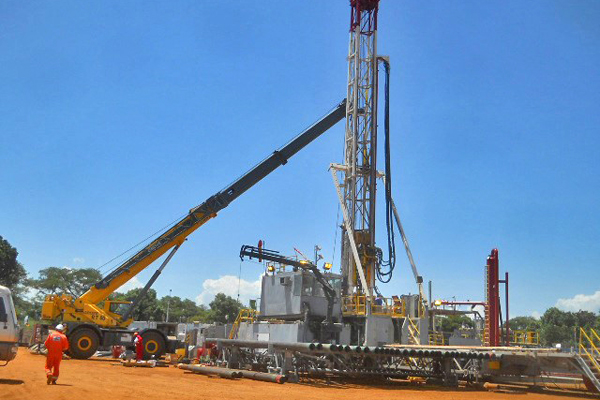US-Chinese company snaps up Shs7t oil deal

A rig drills oil at Ngege -E oil well in Buliisa. PHOTO / FILE
What you need to know:
- Uganda’s oil reserves currently stand at 6.5 billion barrels, of which 1.4 billion barrels is recoverable—the proportion oil that can be technically and economically possible to extract from the ground.
French oil giant, TotalEnergies, has awarded the Engineering, Procurement, and Construction (EPC) tender for its Tilenga oil project in Nwoya and Buliisa districts to a consortium of China’s Sinopec International Petroleum Service Corporation and United States-based McDermott International.
The Shs7 trillion ($2b) EPC tender is, however, subject to approval by Total’s partners, China National Offshore Oil Company (Cnooc), and the Uganda National Oil Company (Unoc).
Total E&P operates the Tilenga project comprising six oil fields to the north and east of Lake Albert, respectively, but Cnooc has equity stake in the fields owing to the joint venture partnership agreement. On the other hand, Unoc holds 15 per cent stake in the six-production licences granted for each of the fields.
In a statement yesterday evening, McDermott’s senior vice president for Europe, Middle East and Africa, Mr Tareq Kawash, described the conditional awarding of the Tilenga EPC as “momentous and essential project for Uganda for the development of its national companies and citizens—and as we continue to grow our footprint in Africa, we are committed to expanding local content opportunities in the communities in which we operate.”
According to the statement, construction and related activities on Tilenga will generate some 20,000 direct and indirect jobs “bringing a significant number of meaningful training opportunities for the local labour force”.
The two companies will in the interim coordinate work on the project from London, UK—for McDermott and Yangzhou, China—for Sinopec, until transitioning to Kampala later this year.
Yesterday’s announcement was a culmination of tight rope pulling between Total E&P and Cnooc, over EPC contractors for both upstream, and midstream, with both companies pulling the tenders to their home countries. A consortium comprising mixed companies is likely the middle ground.
The Tilenga project is expected to produce up to 200,000 barrels per day (kbpd) of crude oil out of six oil fields tapped by 31 well pads which will be connected to the proposed Central Processing Facility (CPF), where crude oil is separated from impurities such as water and sand before being fed into the proposed East African Crude Oil Pipeline (EACOP), or the greenfield refinery. The six oil fields: Ngiri field is expected to produce about 50,00 barrels per day (kbpd); Jobi-Rii 70,000kbpd; Kasamene 20,000 kbpd; Wahirindi 3,250kbpd; Kigogole 20,000kbpd; and Nsoga 20,000kbpd.
China’s Cnooc is in the coming weeks also expected to announce EPC contractor for its Kingfisher project, including development of oil fields and construction of a separate CPF, south of Lake Albert in Hoima and Kikuube districts. The Kingfisher project is expected to produce more than 40,000 bpd.
Uganda’s oil reserves currently stand at 6.5billion barrels, of which 1.4billion barrels is recoverable—the proportion oil that can be technically and economically possible to extract from the ground.
The announcement yesterday adds to the momentum of getting first commercial oil production started at the earliest 2025, following the recent signing of agreements for commercialisation of EACOP to transport Uganda’s crude oil from mid-western Uganda to Tanga port in Tanzania.
This is tagged to investments of between $10b-$15b (Shs36trillion to Shs54trillion) for the required infrastructure, including EACOP, among others.




